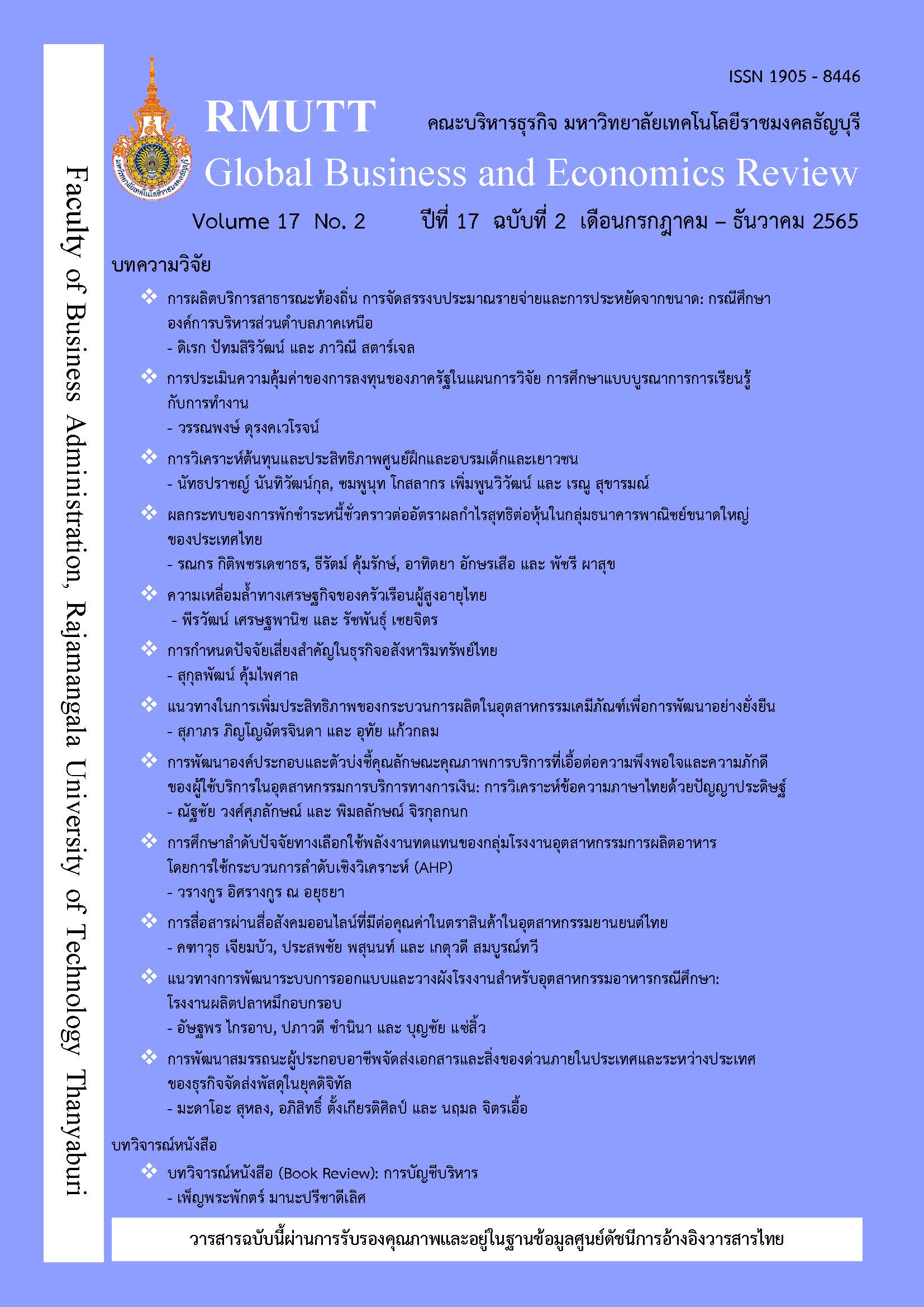A DETERMINATION OF CRITICAL RISK FACTORS IN THAILAND REAL ESTATE BUSINESS
Keywords:
Risk Identification, Real Estate Business, Thailand, EntrepreneursAbstract
This study aims to study risk factors affecting the Thai real estate business, as well as study risk level of various risk factors that occur in Thai real estate development, resulting in risk management guidelines for entrepreneurs. Semi-structured interviews were conducted with 15 key informants who are real estate developers in various regions of Thailand, and the risk score was calculated based on the multiplicative likelihood of risk factors and the degree of risk. The findings revealed that the majority of the Thai real estate business's risk factors were likely to occur, and the level of impact of the risk factors was high. However, when considering the risk rating according to the Stock Exchange of Thailand's organizational risk management framework, it was discovered that three risk factors of the Thai real estate business had a very high level of risk (risk score is between 16.01 - 25.00) as follows:
1) Customers' purchasing power/rental has decreased in the current economic climate, 2) liquidity in the disposition of assets is very low, and 3) the land and building tax raises the cost of land, respectively. These three risk factors are an economic factor and a legal factor which uncontrollable external factor and unavoidable factor for Thai real estate entrepreneurs.
References
กรุงศรีวิจัย. (2564). แนวโน้มธุรกิจ/อุตสาหกรรม ปี 2564-2566: ธุรกิจที่อยู่อาศัยในกรุงเทพฯและปริมณฑล. สืบค้นจาก https://www.krungsri.com/th/research/industry/industry-outlook/Real-Estate/Housing-in-BMR/IO/io-housing-in-BMR-21
กองกูณฑ์ โตชัยวัฒน์. (2561). การพัฒนาโครงการจัดสรร. กรุงเทพฯ: มหาวิทยาลัยธรรมศาสตร์.
จินตวีร์ เกษมสุข. (2554). การสร้างกระบวนการมีส่วนร่วม (เอกสารประกอบการบรรยาย หมวดวิชางานชุมชนและมวลชนสัมพันธ์). กรุงเทพฯ: กองบัญชาการศึกษา สำนักงานตำรวจแห่งชาติ.
ชัยวัฒน์ ริรัตนพงษ์ และคณะ. (2562). การพัฒนาอสังหาริมทรัพย์เบื้องต้น. กรุงเทพฯ: มหาวิทยาลัยธรรมศาสตร์.
ชีวาทัย. (2564). ปัจจัยความเสี่ยง. สืบค้นจาก https://investor.chewathai.com/th/corporate-governance/risk-factors.
ฐิศิรักน์ เชื้อเมืองพาน. (2561). ผลกระทบของเทคโนโลยีตัวกลางจองที่พักออนไลน์ที่มีต่อธุรกิจโรงแรมขนาดกลางและขนาดย่อมในจังหวัดภูเก็ต. (วิทยานิพนธ์วิทยาศาสตรมหาบัณฑิต, มหาวิทยาลัยธรรมศาสตร์).
ตลาดหลักทรัพย์แห่งประเทศไทย. (2557). กรอบการบริหารความเสี่ยงองค์กร (ERM Framework) ฉบับเผยแพร่ทางเว็บไซต์. สืบค้นจาก https://www.set.or.th/th/about/overview/risk-management
ธนาคารเกียรตินาคินภัทร. (2564). สำรวจตลาดอสังหาฯ กลางมรสุมโควิด–19. สืบค้นจาก https://advicecenter.kkpfg.com/th/business-talk/covid-19-impact-on-real-estate
ฝ่ายวิจัยธนาคารกรุงไทย. (2563). ทิศทางเศรษฐกิจและธุรกิจในยุค New Normal. สืบค้นจาก https://krungthai.com/Download/economyresources/EconomyResourcesDownload_447New_Normal_29_05_63.pdf
ยงธนิสร์ พิมลเสถียร และคณะ. (2550). การศึกษาความเหมาะสมในการพัฒนาพื้นที่โครงการเมืองใหม่บางพลีและเคหะชุมชนร่มเกล้าเพื่อรองรับสนามบินสุวรรณภูมิ. กรุงเทพฯ: คณะสถาปัตยกรรมศาสตร์และการผังเมืองมหาวิทยาลัยธรรมศาสตร์.
วุธพงศ์ ลาภเจริญ. (2563). การวิเคราะห์ตลาดและกลยุทธ์การตลาดเพื่อการพัฒนาอสังหาริมทรัพย์. กรุงเทพฯ: เอเชียดิจิตอล การพิมพ์.
ศักรพัฒน์ อนุรักษ์ภราดร และคณะ. (2561). แนวทางการส่งเสริมพื้นที่สุขภาวะกับการใช้ประโยชน์ที่ดินในบริบทการพัฒนาเมืองและอสังหาริมทรัพย์ในเขตชุมชนเมือง. วารสารสาระศาสตร์, 1/2561, 129-138.
ศูนย์ข้อมูลอสังหาริมทรัพย์ ธนาคารอาคารสงเคราะห์. (2562). รายงานประจำปี 2562 Data drive real estate future. สืบค้นจาก https://www.reic.or.th/Upload/AnnualReportREIC2019_34035_1603337640_60529.pdf
สมเกียรติ ตั้งกิจวาณิชย์. (2563). 5 คำถาม และ 4 โจทย์ ว่าด้วยการสนทนาเรื่องความปกติใหม่ในโลกหลังโควิด. สืบค้นจาก https://tdri.or.th/2020/04/new-normal-in-post-covid-world
สมาคมอสังหาริมทรัพย์ไทย. (2564). รายงานประจำปี พ.ศ. 2563. กรุงเทพฯ: สมาคมอสังหาริมทรัพย์ไทย.
สำนักงานคณะกรรมการการส่งเสริมการลงทุน (2560). พระราชบัญญัติส่งเสริมการลงทุน (ฉบับที่ 4) พ.ศ. 2560. สืบค้นจาก https://www.boi.go.th/upload/content/BOI-PRB1-20170314_87384.pdf.
สำนักงานนโยบายและแผนทรัพยากรธรรมชาติและสิ่งแวดล้อม. (2562). การประเมินผลกระทบสิ่งแวดล้อม. สืบค้นจาก https://www.onep.go.th/การประเมินผลกระทบสิ่งแวดล้อม
สำนักงานเศรษฐกิจการคลัง. (2562). พระราชบัญญัติภาษีที่ดินและสิ่งปลูกสร้าง พ.ศ. 2563. กรุงเทพฯ: สำนักงานเศรษฐกิจการคลัง.
สำนักผังประเทศและภาค. (2563). การกำหนดผังนโยบายแต่ละภาคของประเทศไทย. สืบค้นจาก https://office.dpt.go.th/nrp/th/general-press-release
สุกุลพัฒน์ คุ้มไพศาล และคณะ. (2562). การพัฒนาอสังหาริมทรัพย์เบื้องต้น. กรุงเทพฯ: มหาวิทยาลัยธรรมศาสตร์.
อริศรา แก่นเพ็ชร. (2558). การศึกษารูปแบบอาคารชุดพักอาศัยทางด้านกายภาพเพื่อตอบสนองคนเจเนอเรชั่นวายที่ใช้ชีวิตในย่านธุรกิจของกรุงเทพมหานคร. (วิทยานิพนธ์วิทยาศาสตรมหาบัณฑิต, มหาวิทยาลัยธรรมศาสตร์).
อัญชุลี สิมะเสถียร. (2565). การบริหารความเสี่ยงองค์กร: เอกสารประกอบการบรรยายวิชาการบริหารความเสี่ยงในอสังหาริมทรัพย์. กรุงเทพฯ: คณะสถาปัตยกรรมศาสตร์และการผังเมือง มหาวิทยาลัยธรรมศาสตร์.
Adair, A., Berry, J., McGreal, S., Deddis, B., & Hirst, S. (2000). The Financing of urban regeneration. Land Use Policy, 17, 147-156.
Adair, A., & Hutchison, N. (2005). The reporting of risk in real estate appraisal property risk scoring. Journal of Property Investment and Finance, 23(3), 254-268.
Best, J. W. (1977). Research in education (3rd ed). New Jersey: Prentice-Hall.
Chen, Z., & Khumpaisal, S. (2009). An analytic network process for risks assessment in commercial real estate development. Journal of Property Investment and Finance, 27(3), 238-258.
Couch, C., & Dennemann, A. (2000). Urban regeneration and sustainable development in Britain: The example of the Liverpool Ropewalks partnership. Cities, 17(2), 137-147.
Creswell, J. W., & Creswell, J. D. (2018). Research design: Qualitative, quantitative, and mixed methods approaches (5th ed.). Los Angeles: SAGE.
Flyvbjerg, B., Bruzelius, N., & Rothengatter, W. (2003). Megaprojects and risk: An anatomy of ambition. Cambridge, UK: Cambridge University Press.
International Technology Education Association. (2000). Standards for technological literacy: Content for the study of technology (3rd ed.). Reston, Virginia: International Technology Education Association.
Jones, C., & Watkins, C. (1996). Urban regeneration and sustainable markets. Urban Studies, 33(7), 1129-1140.
Khumpaisal, S. (2011). Analytic approach to risk assessment in Thailand’s real estate development industry. (Doctoral Thesis, School of the Built Environment, Liverpool John Moores University, Liverpool, United Kingdom).
Khumpaisal, S. (2015). An examination of economic risks’ perception of Thai real estate developers. International Journal of Trade, Economics, and Finance, 6(1), 14-21.
Khumpaisal, S., Meechai, W., & Bunnag, K. (2017). An investigation of risks factors affect to housing loan’s processes in Thailand commercial banks. Archive of Business Research, 5(8), 40-49.
Kirsty, G. (2010). STEEP theory. Retrieved from http://www.trainingblog.co.uk/2010/03/30/steep-theory
Moss, Q. Z., Alho, J., & Alexander, K. (2007). Performance measurement action research. Journal of Facilities Management, 5(4), 290-300.
Pellman, R. (2008). Heathrow terminal 5: Gaining permission. Proceedings of the Institution of CivilEngineers - Civil Engineering, 161(5), 4-9.
PERSEUS. (2012). Qualitative risk analysis. Retrieved from http://www.perseus-net.eu/site/content. php?artid=2204
Raftery, J. (1994). Risk analysis in project management. London: E & FN Spon.
Richardson, J. V. (2017). A brief intellectual history of the STEPLE model or frameworkical. Retrieved from https://pages.gseis.ucla.edu/faculty/richardson/STEPE.htm
Transparency International. (2018). Corruption perception index 2017. Retrieved from https://bit.ly/ 2BJaDBF
Wang, Y., & Xiang, P. (2019). Investigate the conduction path of stakeholder conflict of urban regeneration sustainability in China: The application of social-based solutions. Sustainability, 11, 5271.
Downloads
Published
How to Cite
Issue
Section
License
Copyright (c) 2022 Sukulpat Khumpaisal

This work is licensed under a Creative Commons Attribution-NonCommercial-NoDerivatives 4.0 International License.
บทความที่ได้รับการตีพิมพ์เป็นลิขสิทธิ์ของผู้นิพนธ์
ข้อความที่ปรากฏในบทความแต่ละเรื่องในวารสารวิชาการเล่มนี้เป็นความคิดเห็นส่วนตัวของผู้เขียนแต่ละท่านไม่เกี่ยวข้องกับมหาวิทยาลัยเทคโนโลยีราชมงคลธัญบุรี และคณาจารย์ท่านอื่นๆในมหาวิทยาลัยฯ แต่อย่างใด ความรับผิดชอบองค์ประกอบทั้งหมดของบทความแต่ละเรื่องเป็นของผู้เขียนแต่ละท่าน หากมีความผิดพลาดใดๆ ผู้เขียนแต่ละท่านจะรับผิดชอบบทความของตนเองแต่ผู้เดียว







